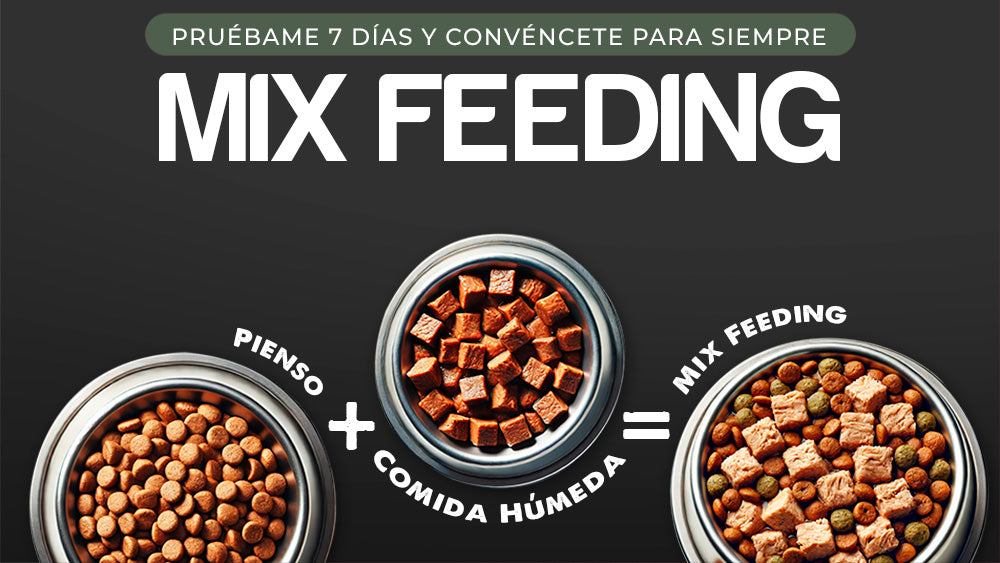
Everything you need to know about mixed feeding for your dog
Healthy and balanced diet
Have you ever heard about mixed feeding and wondered if it's a healthier way to feed your dog? Maybe your furry friend has digestive issues, or you simply want to offer him a more varied diet. In this article, we'll tell you everything you need to know about mixed feeding and how it can benefit your dog.
When we talk about mixed feeding, it's not just about mixing dry food with wet food, but about creating a balance that promotes your pet's health. In this post, we'll explain its benefits and, most importantly, how to do it in a healthy and balanced way for your dog. Read on to learn all about mixed diets for dogs!
What is Mix Feeding?
Mixed feeding is a way of feeding your dog by combining different types of food: dry food, wet food, and, in some cases, homemade food or supplements. This mixed diet seeks to take advantage of the benefits of each type of food to provide a more complete and balanced diet.
Although it may seem like a random combination, the idea is to select products that complement each other and work together. For example, dry food is convenient, nutritious, and helps your dog's dental health, while wet food is usually tastier, easier to digest, and has a high water content, which is beneficial for dogs that don't drink enough water.
Why choose a mixed diet for your dog?
By choosing a mixed diet, you're giving your dog a wider variety of nutrients, which can contribute to better overall health. Plus, by combining different types of food, your dog will enjoy a tastier experience at each meal, which can increase their appetite and motivation to eat.
Mixed feeding is also ideal if your dog has certain special needs, such as digestive issues, food sensitivities, or a very high activity level. Thanks to this diet's flexibility, you can adapt it to your furry friend's needs.
How to make a mixed feeding for your dog?
Now that you know what mixed feeding is, you're probably wondering how to implement it correctly. It's important to consider several factors when creating a mixed diet for dogs, such as the amount of each type of food and how to combine them so your dog receives the right nutrients.
Step 1: Choose quality foods
It's essential that the products you use are high-quality, such as our Fresh Semi-Moist Dry Food or our Canned Wet Food. These products are made with natural, locally sourced ingredients, which means they're easy to digest and highly palatable.
Fresh Semi-Moist Dry Food is perfect for combining with wet food because it has a smooth texture and isn't as dry as traditional dry food. This makes mixing easier and ensures your dog gets the right amount of nutrients.
Wet canned food is also a great option because it provides a large amount of water, which is great for dogs that need more hydration, such as small breeds or older dogs.
Step 2: Determine the appropriate proportions
To achieve a balanced diet for your dog, it's important not to overfeed any one type of food. A common recommendation is to mix dry food with wet food in a 2:1 ratio (two parts dry food to one part wet food). This is only a general guide, as your dog's nutritional needs may vary depending on their age, size, activity level, and health.
If your dog has sensitive digestion, you can opt for easier-to-digest foods, such as our Fresh Meatballs. These meatballs are made with fresh, natural ingredients, making them an excellent addition to a mixed diet. Plus, meatballs are a delicious food that you can also use to mix into meals.
Step 3: Introduce changes gradually
When you start feeding your dog a mixed diet, it's essential to do so gradually to avoid digestive problems. Start with a small amount of the new food and gradually increase the amount of wet food or any other food you've chosen.
A sudden change in diet can cause stomach upset or diarrhea, so it's best to make the transition over several days.
Step 4: Don't forget the fresh water
Although wet food helps with hydration, it's always important to ensure your dog has access to fresh, clean water at all times. This is especially important if you're offering dry food alongside wet food.
Benefits of Mix Feeding for your dog
Now that you know how to mix feed correctly, let's talk about the main benefits your dog will gain from following a mixed diet.
1. Greater nutritional variety
Mixing kibble with wet food offers a wider variety of essential nutrients. Kibble is typically rich in protein, fiber, and fat, while wet food may be richer in vitamins and minerals. This combination ensures your dog gets a more complete and balanced diet.
2. Improves digestibility
Mixing different types of food can improve your dog's digestion. Some dogs have difficulty digesting dry food alone, so including wet or fresh food can make the food easier to process.
3. Greater palatability
Many dogs love wet food because it has a much stronger flavor and aroma than dry food. If your dog is a picky eater, mixed feeding can be the perfect solution to increase their appetite.
4. Dental health benefits
Dry food is ideal for maintaining your dog's dental health. Kibble helps reduce tartar and plaque buildup on teeth. Combining it with wet food doesn't interfere with this benefit, as both types of food provide something different and complementary.
FAQ about Mixed Feeding for Dogs
1. Can I mix feed with homemade food for my dog?
Yes, you can mix kibble with homemade food, but it's important to ensure the homemade food is nutrient-balanced. Consult a veterinarian if you're unsure how to prepare a suitable homemade diet.
2. Is it better to give my dog wet food or dry food?
Both have their advantages. Dry food is more convenient and good for dental health, while wet food is tastier and helps with hydration. The ideal is to combine both in a mixed feeding.
3. How much dry and wet food should I give my dog?
The amount depends on your dog's size and needs. As a general rule, you can feed two parts dry food to one part wet food. Be sure to adjust the amount to maintain a balanced diet.
4. Is mixed feeding suitable for dogs with food allergies?
If your dog has allergies, it's crucial to select hypoallergenic foods for the mixed diet. Consult your veterinarian to choose products that don't contain ingredients that may cause reactions.
5. Can I give treats while following a mixed feeding plan?
Of course! Treats like Natural Snacks are an excellent option to complement the diet. Just remember to adjust the amounts of the main meal so you don't overfeed your dog.
Mixed feeding is an excellent way to give your dog a healthier, tastier, and more balanced diet. With products like Fresh Semi-Moist Feed, the Wet Food Cans and the delicious Fresh Meatballs, you can ensure your furry friend is getting the best of both worlds: flavor, nutrition, and ease of digestion.


